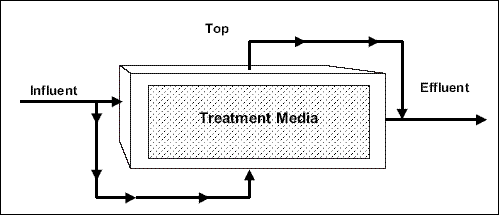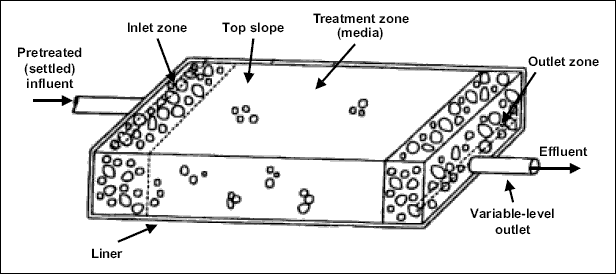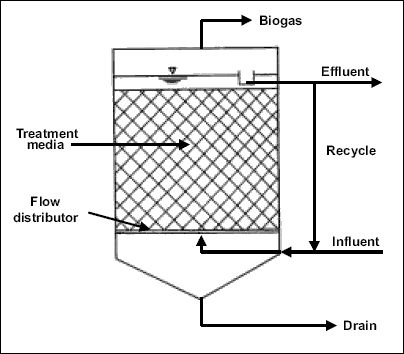Vegetated Submerged Beds and
Other High-Specific-Surface Anaerobic Reactors...

Source : EPA...
Description...
A high-specific-surface anaerobic reactor (Figure 1) is any tank or cavity filled with solid media through which
wastewater flows with a high hydraulic retention time (HRT). In onsite treatment the two primary types are vegetated
submerged beds (VSBs) and anaerobic upflow filters (AUFs). The first is characterized by horizontal flow and prolific
growth of macrophytes on the surface. The second comes in a variety of forms from upflow sludge blanket systems and fixed
media anaerobic filters to partially fluidized beds of fine media. Both have long HRTs, produce anaerobic effluents,
generally treat either high-strength or minimally pretreated wastewater, and usually require some form of posttreatment to
meet surface discharge or water reuse requirements. The primary removal mechanisms in all of these systems are physical,
that is, floculation, sedimentation, and adsorption. Anaerobic biological reactions are extremely slow and do not have a
significant impact on soluble BOD until HRTs become quite long. Some toxic organic compounds may be reduced through these
mechanisms and chemical precipitation (e.g., sulfides) at shorter HRTs.

Figure 1. Generic high-specific surface anaerobic reactor.
VSBs, as shown in Figure 2, usually follow a septic tank and remove most of the suspended and larger colloidal particles,
BOD, organic forms of nitrogen, and other particles. Although they are frequently identified as subsurface constructed
wetlands, they do not fit the strict definition of a constructed wetland. Three types of AUFs can be used as pretreatment
devices for high-strength wastewater and some onsite pretreatment applications in the United States. They are in shown in
Figures 3, 4, and 5. Figure 3, with a rock medium, is the most typical U.S. application.


Figure 2. Elements of a vegetated submerged bed (VSB) system.

Figure 3. Schematic of the upflow anaerobic filter process.

Figure 4. Schematic of the upflow anaerobic sludge blanket process.

Figure 5. Schematic of the anaerobic fluidized bed process.
Typical Applications...
AUFs are widely used in hot climates where domestic wastewaters are several times higher in strength than U.S.
wastewaters. These systems can reduce high BOD and TSS to levels that can be readily treated by typical aerobic processes
such as suspended and fixed growth aerobic units or recirculating/intermittent media filters. International literature
contains numerous references to the three types of AUFs and their valuable contributions to water pollution abatement.
Anaerobic rock upflow filters (Figure 6) are also used to lower septic tank effluent BOD and TSS concentrations prior to
discharge to the subsurface wastewater infiltration system (SWIS).

Figure 6. Anaerobic upflow filter.
VSBs are extremely popular in the United States because of their aesthetic features and their ability to meet basic
(secondary) effluent standards when treating septic tank effluent. Until recently they were purported to be capable of
nitrification and nutrient removal at economically competitive HRTs. Since they are largely anaerobic, this would be
biochemically impossible. However, they are fully capable of meeting secondary BOD and TSS standards. They are also
sometimes used before a SWIS and can meet the same effluent TSS and BOD standards as aerobic units (Technology Fact
Sheets 1, 2, and 3). VSBs can be considered as pretreatment units regarding SWIS design requirements. They do not,
however, remove more than 2 logs of fecal coliform and would likely require disinfection for direct surface discharge.
They also require some form of aeration to meet effluent standards for dissolved oxygen (DO). These VSBs will capture
rainfall and snowmelt, effluent standards for requiring adjustment to designs of SWIS following these units. Both VSBs and
AUFs are being used in rural areas in combination with aerobic processes to remove significant amounts of nitrogen through
denitrification. These processes are included in the nutrient removal fact sheets.
Design Assumptions...
VSB design guidance for small communities is provided in Table 1. In the first few months of operation, excellent
phosphorus removal will occur until the rock medium becomes saturated with phosphorus and breakthrough occurs.
(Note : USEPA guidance on design of VSBs can be found in Manual: Constructed Wetlands Treatment of Municipal Wastewater,
posted at http://www.epa.gov/ordntrnt/ord/nrmrl/pubs/2001/wetlands/625r99010.pdf) Except for the anaerobic upflow rock
filter, AUFs are rarely employed for U.S. onsite applications. Since the primary purpose of these systems is to improve
the BOD and TSS of septic tank effluent, they are essentially physical processes. Therefore, they must be designed to
maximize their flocculation and sedimentation functions. Limited field studies indicate that successful removal of
particulate BOD and TSS could be obtained with an average HRT between 16 and 24 hours, rounded media size of 1 to 2 inches
or greater, and a means of periodically draining excess accumulated solids from the bottom of the unit. At higher
temperatures, some partial digestion of accumulated organic solids occurs. This liquefaction may by accompanied by gas
production. The amount and makeup of that gas depend on pH, wastewater constituents (e.g., protein, lipids, carbohydrates),
sulfate, alkalinity, and other constituents.
Table 1. Summary of VSB design guidance.
 Performance...
VSB systems can treat septic tank effluent to a BOD of 20 to 30 mg/L, depending on the organic loading rate chosen. The
VSB effluent TSS is almost always less than 30 mg/L. Some removal of all constituents (e.g., heavy metals, organic
nitrogen and organic phosphorus, pesticides, and other toxic organics) can also be expected. Over and above these
removals, there will be some small percentage of dissolved organic removal owing to anaerobic biological activity.
Rock AUFs after septic tanks have not been widely studied, but they appear to remove TSS by as much as 55 percent from
septic tank effluent, while removing a similar percent of the BOD. Actual removals will depend on the specific fractions
of particulate, colloidal, and soluble matter in the septic tank effluent. Little soluble or fine particulate removal is
likely. Both systems will remove pathogens, with VSBs capable of removing from 1 to 3 logs (design average = 2 logs),
while AUF removal is estimated to be closer to 1 log because of shorter HRTs.
Management Needs...
All of these anaerobic systems are passive in nature and require minimal O/M activity. AUF units may be constructed
aboveground, but they usually are below the ground surface to provide insulation and protect against severe climatic
conditions. The solid medium can be a coarse gravel or one of many commercially available synthetic media that will not
easily clog with biomass. Access to inlet and outlet systems should be provided for purposes of cleaning and servicing.
An easily accessible means to drain the unit and an effective alarm system should be provided. VSB units are generally
aesthetically pleasing additions to the landscape if sufficient area is available for their application. It is estimated
that fewer than 4 hours per year will be required for O/M tasks, which will involve inspecting the system and making any
adjustments required. Therefore, until more information becomes available, a site visit schedule of three to four times a
year is suggested.
Performance...
VSB systems can treat septic tank effluent to a BOD of 20 to 30 mg/L, depending on the organic loading rate chosen. The
VSB effluent TSS is almost always less than 30 mg/L. Some removal of all constituents (e.g., heavy metals, organic
nitrogen and organic phosphorus, pesticides, and other toxic organics) can also be expected. Over and above these
removals, there will be some small percentage of dissolved organic removal owing to anaerobic biological activity.
Rock AUFs after septic tanks have not been widely studied, but they appear to remove TSS by as much as 55 percent from
septic tank effluent, while removing a similar percent of the BOD. Actual removals will depend on the specific fractions
of particulate, colloidal, and soluble matter in the septic tank effluent. Little soluble or fine particulate removal is
likely. Both systems will remove pathogens, with VSBs capable of removing from 1 to 3 logs (design average = 2 logs),
while AUF removal is estimated to be closer to 1 log because of shorter HRTs.
Management Needs...
All of these anaerobic systems are passive in nature and require minimal O/M activity. AUF units may be constructed
aboveground, but they usually are below the ground surface to provide insulation and protect against severe climatic
conditions. The solid medium can be a coarse gravel or one of many commercially available synthetic media that will not
easily clog with biomass. Access to inlet and outlet systems should be provided for purposes of cleaning and servicing.
An easily accessible means to drain the unit and an effective alarm system should be provided. VSB units are generally
aesthetically pleasing additions to the landscape if sufficient area is available for their application. It is estimated
that fewer than 4 hours per year will be required for O/M tasks, which will involve inspecting the system and making any
adjustments required. Therefore, until more information becomes available, a site visit schedule of three to four times a
year is suggested.
Residuals generate in VSB systems at a slow rate. Although the system inlet where most solids accumulate can be excavated
or piped for high-pressure removal, it is more likely that a replacement system would be built after the service life of
the original system ends. AUF units will require periodic flushing of accumulated solids and inspection of inlet and outlet
systems. If solids are allowed to accumulate, the filter may clog or release high solids “events” to the SWIS. This will
clog the infiltrative surface or the distribution system. Therefore, a site visit schedule of three to four times per year
is suggested until more information becomes available. This would entail from 6 to 8 hours per year of labor. Disposal and
transport of excess solids will require similar management to septage.
Risk Management Issues...
VSB systems can usually handle the flow variations likely to occur from residential sources, as well as toxic shock loads
and power outages. Reed and colleagues (1995) proposed some models to support the view that insulation provided by dead
vegetation (litter) on the surface should aid these systems during typical winters in northern climates. The potential
for odor is low for properly sized systems. AUF systems should also accommodate typical flow variations, toxic shocks, and
power outages. They should be insulated from cold weather. AUFs are inherently odor and corrosion generators, so
corrosion-resistant materials should be employed. Odor (hydrogen sulfide) production may require the use of an odor-control
system (e.g., soil filters) to deodorize off-gases.
Costs...
VSB systems for onsite application will cost about $20 per square foot (USEPA, 1999). Almost half of that cost is for the
media, while excavation, liner, plants, control structures, and piping make up the rest. Operation and maintenance costs
would run less than $100 per year if these services are professionally provided. AUF systems are likely to cost about
$1,000 to $1,500 per house, primarily related to the cost of the tank and related containment features. O/M costs would run
around $200 per year, including solids transport as required.











